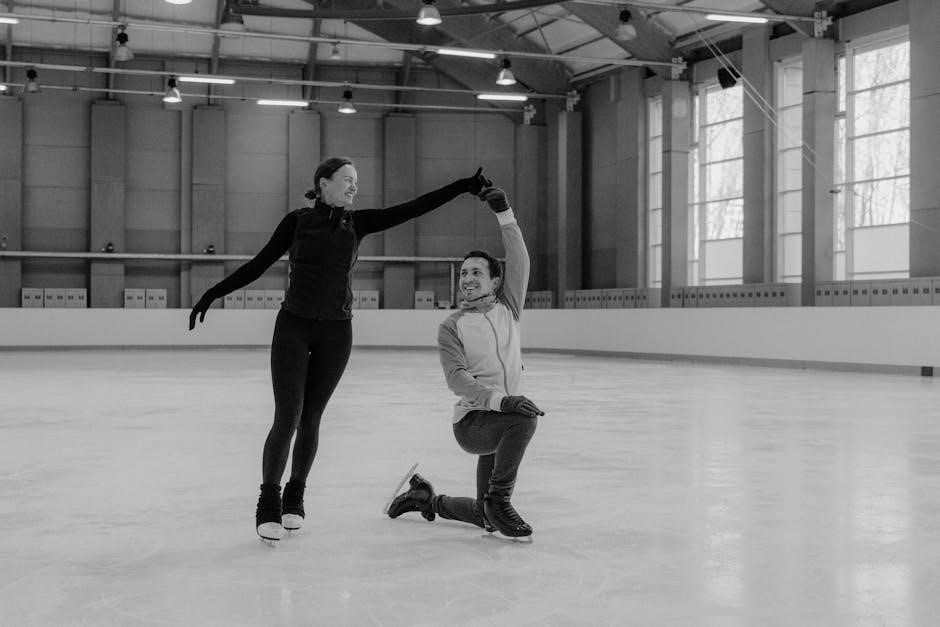Post-lumbar fusion surgery, exercises are crucial for recovery and spinal stability. This guide outlines essential exercises, focusing on core strength, flexibility, and proper techniques to ensure a safe and effective rehabilitation journey.
Overview of Lumbar Fusion Surgery
Lumbar fusion surgery is a procedure to stabilize the spine by fusing two or more vertebrae together. It is often performed to treat conditions like spondylolisthesis, degenerative disc disease, or spinal instability. The surgery involves removing the disc between the affected vertebrae and inserting a bone graft or implant to promote fusion. Over time, the vertebrae grow together, reducing pain and improving stability. Minimally invasive techniques, such as oblique lumbar interbody fusion (OLIF), are increasingly used to minimize tissue damage and recovery time. The goal of the surgery is to alleviate symptoms like back pain, numbness, or weakness caused by spinal instability. While the procedure is effective, it requires careful post-operative care and rehabilitation to ensure proper healing and optimal outcomes. Understanding the surgical process and its objectives is essential for patients preparing for recovery and rehabilitation.
Importance of Post-Operative Exercises
Post-operative exercises play a vital role in recovery after lumbar fusion surgery. They help restore strength, flexibility, and mobility while minimizing the risk of complications. Proper exercises promote spinal stability, reduce muscle atrophy, and improve overall functional ability. Core stability is particularly crucial, as it supports the spine and prevents further injury. Stretching and strengthening exercises target key muscle groups, such as the hamstrings and hip flexors, which are often tight and contribute to back pain. Additionally, exercises like Pilates have been shown to be beneficial in maintaining spinal health and reducing recurrence of pain. A well-structured exercise program can enhance the surgical outcome, accelerate recovery, and help patients return to their daily activities. Consistency and adherence to a prescribed routine are essential for achieving long-term benefits and ensuring proper healing of the fused vertebrae.

Core Stability and Strengthening
Core stability is essential for spinal support and balance. Exercises like planks and bridges strengthen abdominal and back muscles, enhancing posture and reducing muscle strain after lumbar fusion surgery.
4.1 Core Exercises
Core exercises are fundamental for rebuilding strength and stability post-lumbar fusion surgery. Gentle exercises like planks, bridges, and bird-dog movements target abdominal and back muscles. Planks strengthen the transverse abdominis, while bridges enhance gluteal and lower back muscles. Bird-dog exercises improve balance and coordination. These exercises should be performed with controlled movements, avoiding strain. Starting with short durations and gradually increasing intensity is key. It’s important to focus on proper form to prevent injury. Many patients find Pilates beneficial, as it emphasizes core engagement without excessive strain. Always consult a physical therapist to tailor exercises to individual needs and progress safely. Consistency in these exercises helps restore spinal stability and promotes long-term recovery.
4.2 Benefits of Core Stability
Core stability is essential for post-lumbar fusion recovery, as it provides a strong foundation for the spine. A stable core reduces strain on the fused vertebrae, minimizing the risk of complications. Improved posture and reduced back pain are significant benefits, as the muscles work synergistically to support the spine. Strengthening the core also enhances balance and coordination, reducing the likelihood of falls or injuries. Additionally, core stability promotes proper movement patterns, which are critical for daily activities and physical therapy exercises. Over time, a strong core can improve overall physical function and quality of life. It’s important to focus on exercises that target the transverse abdominis and lumbar multifidus muscles, as they play a key role in spinal stability. Consistent core work helps patients regain independence and confidence in their mobility post-surgery.

Hamstring and Hip Flexibility
Hamstring and hip flexibility are crucial for reducing tension on the lower back post-surgery. Tight hamstrings can exacerbate back pain, while improved hip mobility enhances overall spinal alignment and movement efficiency.
5.1 Hamstring Stretches
Hamstring stretches are essential for improving flexibility and reducing lower back strain after lumbar fusion surgery. Tight hamstrings can pull on the pelvis, increasing stress on the spine. Gentle stretching helps alleviate this tension.
- Seated Hamstring Stretch: Sit on the floor with legs extended, feet flexed. Lean forward from the hips until a stretch is felt in the back of the thighs. Hold for 20-30 seconds.
- Standing Hamstring Stretch: Stand with feet shoulder-width apart. Bend forward at the hips, keeping knees slightly bent, until a stretch is felt. Avoid bouncing or forcing the stretch.
These stretches should be performed 2-3 times daily, holding each for 20-30 seconds. Consistency is key to maintaining flexibility and supporting spinal recovery. Always consult a healthcare provider before starting any exercise routine post-surgery.
5.2 Hip Flexor Stretching
Hip flexor stretching is vital for maintaining proper posture and reducing strain on the lower back after lumbar fusion surgery. Tight hip flexors can lead to poor posture and increased stress on the spine.
- Kneeling Hip Flexor Stretch: Start on your hands and knees. Bring one knee forward, placing your foot flat on the ground in front of the other knee. Lean forward gently until a stretch is felt in the front of your hip. Hold for 20-30 seconds and switch sides.
- Standing Hip Flexor Stretch: Stand with one hand on a chair for balance. Bend one knee, keeping your foot behind you, until a stretch is felt in the front of your hip. Hold for 20-30 seconds and repeat on the other side.
Perform these stretches 2-3 times daily to improve flexibility and support spinal recovery. Avoid bouncing or forcing the stretch, as this could cause injury. Always consult your healthcare provider before starting any new exercise routine.

Strengthening Lumbar Extensor Muscles
Strengthening the lumbar extensor muscles is essential for post-lumbar fusion recovery, as these muscles play a critical role in supporting the spine and maintaining proper posture. Weakness in this area can lead to poor spinal stability and increased risk of re-injury.

- Bird Dog Exercise: Start on your hands and knees. Extend one arm and the opposite leg simultaneously, holding for 5 seconds. This improves balance and strengthens the extensor muscles.
- Superman Exercise: Lie on your stomach with arms extended. Lift your arms, shoulders, and legs off the ground, holding for 5-10 seconds; This targets the erector spinae muscles.
- Bridge Exercise: Lie on your back with knees bent. Slowly lift your hips toward the ceiling, squeezing your glutes at the top. This strengthens the lower back and glutes.
Perform these exercises 2-3 times daily, gradually increasing repetitions as strength improves. Consistency is key to rebuilding lumbar extensor muscle strength and ensuring long-term spinal stability. Always consult your healthcare provider before starting any new exercise routine.
Lumbar Multifidus Activation
Lumbar multifidus activation is a critical component of post-lumbar fusion rehabilitation, focusing on re-engaging the deep stabilizing muscles of the spine. The multifidus muscles play a key role in segmental spinal stability, often weakened after surgery.
- Prone Arm Lift: Lie on your stomach with arms extended. Slowly lift one arm off the ground, keeping it straight, and hold for 5 seconds. Alternate sides to target both sides of the multifidus.
- Pelvic Tilts: Start on your back with knees bent. Gently tilt your pelvis upward, flattening your lower back against the floor. Hold for 5-10 seconds and repeat 10-15 times.
- Wall Slide: Stand with your back against a wall and feet shoulder-width apart. Slowly slide down the wall, maintaining contact with your sacrum, and hold for 10 seconds before returning to the starting position.
These exercises should be performed 2-3 times daily, starting with gentle repetitions and gradually increasing intensity. Proper activation of the lumbar multifidus helps restore spinal stability and reduces the risk of future injury. Always consult your physical therapist or healthcare provider to ensure proper form and progression.

Minimizing Risks and Complications
Minimizing risks and complications after lumbar fusion surgery requires careful adherence to post-operative exercise guidelines. Avoiding heavy lifting, bending, or twisting is crucial to prevent strain on the fused spine. Gentle exercises, such as pelvic tilts and bridging, can help strengthen the surrounding muscles without risking injury. Proper form and technique are essential to avoid overloading the spine. Patients should also monitor for signs of complications, such as increased pain or numbness, and report them to their healthcare provider immediately. Adhering to a structured physical therapy program can significantly reduce the risk of adverse events. Additionally, maintaining a healthy weight and avoiding smoking can promote optimal healing. By following these precautions, patients can ensure a safer and more effective recovery process.

Step-by-Step Exercise Guide
A well-structured exercise program is essential for recovery after lumbar fusion surgery. Begin with gentle movements, such as pelvic tilts and deep breathing exercises, to improve mobility and reduce stiffness. Progress to core-strengthening exercises like planks and bird-dog stretches to enhance spinal stability. Hamstring and hip flexor stretches should be incorporated to alleviate tightness and improve flexibility. Strengthening exercises for the lumbar extensor muscles, such as Superman and lat pulldowns, can be added as strength improves. Low-impact cardio, such as walking or swimming, is recommended to promote overall fitness without straining the spine. Always consult with a physical therapist to tailor exercises to individual needs and ensure proper form. Avoid high-impact activities until fully cleared by your healthcare provider. Consistency and patience are key to a successful recovery.

What to Avoid During Recovery
During recovery from lumbar fusion surgery, it is crucial to avoid activities that may strain the spine or disrupt the fusion process. Avoid heavy lifting, bending, or twisting, as these can compromise the stability of the surgical site. High-impact activities, such as running or jumping, should be avoided until cleared by your doctor. Smoking and excessive alcohol consumption can hinder healing and should be avoided. Additionally, avoid sitting or standing for prolonged periods without taking regular breaks to stretch. Do not ignore pain or discomfort, as this can signal improper healing or complications. Avoid returning to strenuous work or hobbies too soon, as this may delay recovery. Always consult your healthcare provider before resuming any activity to ensure it is safe and appropriate for your stage of recovery.

Role of Physical Therapy
Physical therapy plays a vital role in recovery after lumbar fusion surgery, helping patients regain strength, mobility, and flexibility. A tailored exercise program designed by a physical therapist ensures safe and effective progress. Therapy focuses on improving core stability, strengthening the lumbar extensor muscles, and enhancing hamstring and hip flexor flexibility. It also addresses proper posture and body mechanics to reduce strain on the spine. Physical therapists guide patients through gradual exercises, avoiding activities that may compromise the fusion. They monitor progress, adjust routines as needed, and provide feedback to prevent improper movements. Regular sessions help minimize complications and accelerate healing. By adhering to a physical therapy plan, patients can achieve optimal outcomes, reducing the risk of long-term back pain and improving overall quality of life. Professional guidance ensures a structured and safe approach to rehabilitation, making physical therapy an essential component of post-operative care.

When to Start Exercises
Exercises after lumbar fusion surgery should typically begin once cleared by your surgeon, usually around 6–8 weeks post-operatively. Early movement is encouraged to prevent stiffness, but vigorous exercises must wait until the fusion site is stable. Your surgeon may approve light activities like walking and gentle stretching during the initial recovery phase. A structured exercise program, supervised by a physical therapist, is often introduced after the first few weeks. Timing varies based on individual healing progress and the surgeon’s assessment. It’s crucial to avoid premature exertion to protect the surgical site and ensure proper fusion. Always follow your healthcare provider’s guidance to safely initiate exercises and progress gradually. Monitoring by a physical therapist helps tailor the program to your specific needs, ensuring a safe and effective recovery journey.
Pilates and Its Benefits
Pilates is a low-impact exercise method that can be highly beneficial for patients recovering from lumbar fusion surgery. It focuses on strengthening the core muscles, improving posture, and enhancing flexibility. Many individuals, including those who practiced Pilates before surgery, report that it helps reduce back pain and improves overall spinal stability. The controlled movements in Pilates can strengthen the muscles around the spine without putting excessive strain on the surgical site. Additionally, Pilates promotes body awareness, which is crucial for maintaining proper alignment and preventing further injury. However, it’s important to modify Pilates exercises to suit the post-operative phase and avoid any movements that could compromise the fusion. A physical therapist can tailor a Pilates-based program to address specific needs and ensure a safe, effective recovery. Incorporating Pilates into the rehabilitation routine can lead to improved strength, flexibility, and long-term spinal health.
Walking as Initial Exercise
Walking is often recommended as the first exercise after lumbar fusion surgery, typically starting within the initial 6 weeks of recovery. It is a low-impact activity that promotes blood circulation, reduces stiffness, and helps restore mobility without putting excessive strain on the spine. Patients are encouraged to begin with short, gentle walks and gradually increase the distance and duration as their strength improves. Proper posture should be maintained during walking to avoid unnecessary stress on the lower back. Additionally, using a brace or supportive device, as advised by the surgeon, can provide stability during these early walks. It’s important to avoid overexertion and listen to the body’s signals to prevent discomfort or pain. Walking is a foundational step in the rehabilitation process, laying the groundwork for more advanced exercises later in recovery. Always consult with a healthcare provider before starting any exercise program post-surgery.
Monitoring Progress
Monitoring progress after lumbar fusion surgery is essential to ensure a safe and effective recovery. Patients should track improvements in pain levels, mobility, and strength. Setting realistic goals and documenting achievements helps maintain motivation. Regular follow-ups with healthcare providers are crucial to assess healing and adjust exercise routines as needed. Pain levels should be closely observed; any significant increase may indicate overexertion or complications. A daily journal can be useful to record exercise performance, discomfort, and overall well-being. Progress in physical therapy sessions, such as increased range of motion or strength, should also be noted. Celebrating small milestones, like walking farther or performing exercises without pain, can boost confidence and encourage continued adherence to the rehabilitation plan. Consistent monitoring ensures that the recovery stays on track and any potential issues are addressed promptly. This proactive approach supports long-term spinal health and functional recovery. Regular communication with the healthcare team is key to optimizing outcomes.
Adjusting Exercise Routine
Adjusting the exercise routine after lumbar fusion surgery is crucial to ensure continued progress and avoid plateaus or overexertion. As strength and mobility improve, exercises can be gradually intensified by increasing repetitions, duration, or resistance. For example, gentle stretches can transition to more dynamic movements, and light resistance bands can be introduced for strengthening. However, any changes should be made under the guidance of a physical therapist to prevent injury. If certain exercises cause discomfort or pain, they should be modified or replaced with alternatives that are better tolerated. Progression should be slow and controlled, allowing the body to adapt without risking the surgical site. Regular communication with the healthcare team ensures that adjustments align with individual recovery goals and overall spinal health. By tailoring the routine to current abilities and needs, patients can optimize their rehabilitation outcomes and achieve a stronger, more stable spine. Consistent yet cautious progression is key to long-term success.
In conclusion, a well-structured exercise program is essential for recovery after lumbar fusion surgery. Consistency and patience are key, as progress may be gradual. Exercises should focus on core stability, flexibility, and strengthening without overexertion. It is crucial to follow a personalized plan tailored by healthcare providers, ensuring safety and effectiveness. Monitoring progress and adjusting routines as needed helps maintain optimal recovery; Remember, while exercise is vital, rest and avoiding harmful activities are equally important. By adhering to these guidelines, patients can achieve improved mobility, reduced pain, and a stronger spinal foundation for long-term well-being. Always consult with a medical professional before starting or modifying any exercise program to ensure it aligns with individual recovery goals and promotes the best possible outcomes.
